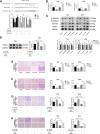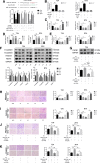Long non-coding RNA ZEB1-AS1 regulates miR-200b/FSCN1 signaling and enhances migration and invasion induced by TGF-β1 in bladder cancer cells
- PMID: 30823924
- PMCID: PMC6397446
- DOI: 10.1186/s13046-019-1102-6
Long non-coding RNA ZEB1-AS1 regulates miR-200b/FSCN1 signaling and enhances migration and invasion induced by TGF-β1 in bladder cancer cells
Abstract
Background: The effect of competing endogenous RNA (ceRNA) can regulate gene expression by competitively binding microRNAs. Fascin-1 (FSCN1) plays an important role in the regulation of cellular migration and invasion during tumor progression, but how its regulatory mechanism works through the ceRNA effect is still unclear in bladder cancer (BLCA).
Methods: The role of fascin-1, miR-200b, and ZEB1-AS1 in BLCA was investigated in vitro and in vivo. The interaction between fascin-1, miR-200b, and ZEB1-AS1 was identified using bioinformatics analysis, luciferase activity assays, RNA-binding protein immunoprecipitation (RIP), quantitative PCR, and western blotting. Loss (or gain)-of-function experiments were performed to investigate the biological roles of miR-200b and ZEB1-AS1 on migration, invasion, proliferation, cell apoptosis, and cell cycle.
Results: ZEB1-AS1 functions as a competing endogenous RNA in BLCA to regulate the expression of fascin-1 through miR-200b. Moreover, the oncogenic long non-coding RNA ZEB1-AS1 was highly expressed in BLCA and positively correlated with high tumor grade, high TNM stage, and reduced survival of patients with BLCA. Moreover, ZEB1-AS1 downregulated the expression of miR-200b, promoted migration, invasion, and proliferation, and inhibited apoptosis in BLCA. Furthermore, we found TGF-β1 induced migration and invasion in BLCA by regulating the ZEB1-AS1/miR-200b/FSCN1 axis.
Conclusion: The observations in this study identify an important regulatory mechanism of fascin-1 in BLCA, and the TGF-β1/ZEB1-AS1/miR-200b/FSCN1 axis may serve as a potential target for cancer therapeutic purposes.
Keywords: Bladder cancer; Long non-coding RNA ZEB1-AS1; TGF-β1; fascin1; microRNA miR-200b.
Conflict of interest statement
Ethics approval and consent to participate
The protocols used in the study were approved by the Hospital’s Protection of Human Subjects Committee. The Institutional Animal Care and Use Committee of China Medical University approved all the experimental procedures of animal experiments.
Consent for publication
Consent for publication was obtained from all participants.
Competing interests
The authors declare that they have no competing interests.
Publisher’s Note
Springer Nature remains neutral with regard to jurisdictional claims in published maps and institutional affiliations.
Figures






Similar articles
-
Long non-coding RNA urothelial cancer-associated 1 promotes bladder cancer cell migration and invasion by way of the hsa-miR-145-ZEB1/2-FSCN1 pathway.Cancer Sci. 2016 Jan;107(1):18-27. doi: 10.1111/cas.12844. Epub 2015 Dec 11. Cancer Sci. 2016. PMID: 26544536 Free PMC article.
-
Long noncoding RNA CDKN2B-AS1 silencing protects against esophageal cancer cell invasion and migration by inactivating the TFAP2A/FSCN1 axis.Kaohsiung J Med Sci. 2022 Dec;38(12):1144-1154. doi: 10.1002/kjm2.12596. Epub 2022 Sep 26. Kaohsiung J Med Sci. 2022. PMID: 36161699 Free PMC article.
-
Inhibition of LncRNA FOXD3-AS1 suppresses the aggressive biological behaviors of thyroid cancer via elevating miR-296-5p and inactivating TGF-β1/Smads signaling pathway.Mol Cell Endocrinol. 2020 Jan 15;500:110634. doi: 10.1016/j.mce.2019.110634. Epub 2019 Oct 31. Mol Cell Endocrinol. 2020. PMID: 31678422
-
A review on the role of ZEB1-AS1 in human disorders.Pathol Res Pract. 2023 May;245:154486. doi: 10.1016/j.prp.2023.154486. Epub 2023 Apr 26. Pathol Res Pract. 2023. PMID: 37120907 Review.
-
Extracellular vesicles promote esophageal cancer progression by delivering lncZEB1-AS1 between cells.Eur Rev Med Pharmacol Sci. 2018 May;22(9):2662-2670. doi: 10.26355/eurrev_201805_14962. Eur Rev Med Pharmacol Sci. 2018. PMID: 29771414 Review.
Cited by
-
Long Non-coding RNA: An Emerging Contributor and Potential Therapeutic Target in Renal Fibrosis.Front Genet. 2021 Jul 27;12:682904. doi: 10.3389/fgene.2021.682904. eCollection 2021. Front Genet. 2021. PMID: 34386039 Free PMC article. Review.
-
LncRNA LOC146880 promotes esophageal squamous cell carcinoma progression via miR-328-5p/FSCN1/MAPK axis.Aging (Albany NY). 2021 May 18;13(10):14198-14218. doi: 10.18632/aging.203037. Epub 2021 May 18. Aging (Albany NY). 2021. PMID: 34016787 Free PMC article.
-
Upregulation of miR-1825 inhibits the progression of glioblastoma by suppressing CDK14 though Wnt/β-catenin signaling pathway.World J Surg Oncol. 2020 Jun 30;18(1):147. doi: 10.1186/s12957-020-01927-3. World J Surg Oncol. 2020. PMID: 32605563 Free PMC article.
-
Fascin-1 is Highly Expressed Specifically in Microglia After Spinal Cord Injury and Regulates Microglial Migration.Front Pharmacol. 2021 Sep 27;12:729524. doi: 10.3389/fphar.2021.729524. eCollection 2021. Front Pharmacol. 2021. PMID: 34646136 Free PMC article.
-
Explore prognostic biomarker of bladder cancer based on competing endogenous network.Biosci Rep. 2020 Dec 23;40(12):BSR20202463. doi: 10.1042/BSR20202463. Biosci Rep. 2020. PMID: 33169791 Free PMC article.
References
MeSH terms
Substances
Grants and funding
LinkOut - more resources
Full Text Sources
Medical
Miscellaneous

